Earlier this year the comics publisher Ablaze released the original graphic novel, TOLKIEN: LIGHTNING UP THE DARKNESS.
This OGN biography vividly explores the youth of John Ronald Reuel Tolkien, the author of The Lord of the Rings saga, and his traumatic experience of the battlefields of the First World War, which forged the imagination of his later literary works and also serves as a useful visual aid for educators teaching the works of Tolkien.

This graphic novel, written by Willy Duraffourg with art by Giancarlo Caracuzzo explores the youth of the author of The Lord of the Rings and his traumatic experience of the battlefields of the First World War, which will forge the imagination of his literary work.
JRR Tolkien was not always the old Oxford professor, pipe in the mouth, refining his extraordinary work. In 1915, at age 23, he left for the front with his high school friends, whom he loved like brothers. They take part in the Battle of the Somme which will kill 450,000 people. The horror of war will brand his relationship to friendship, love, and creation.
Check out the following preview pages and interview below:
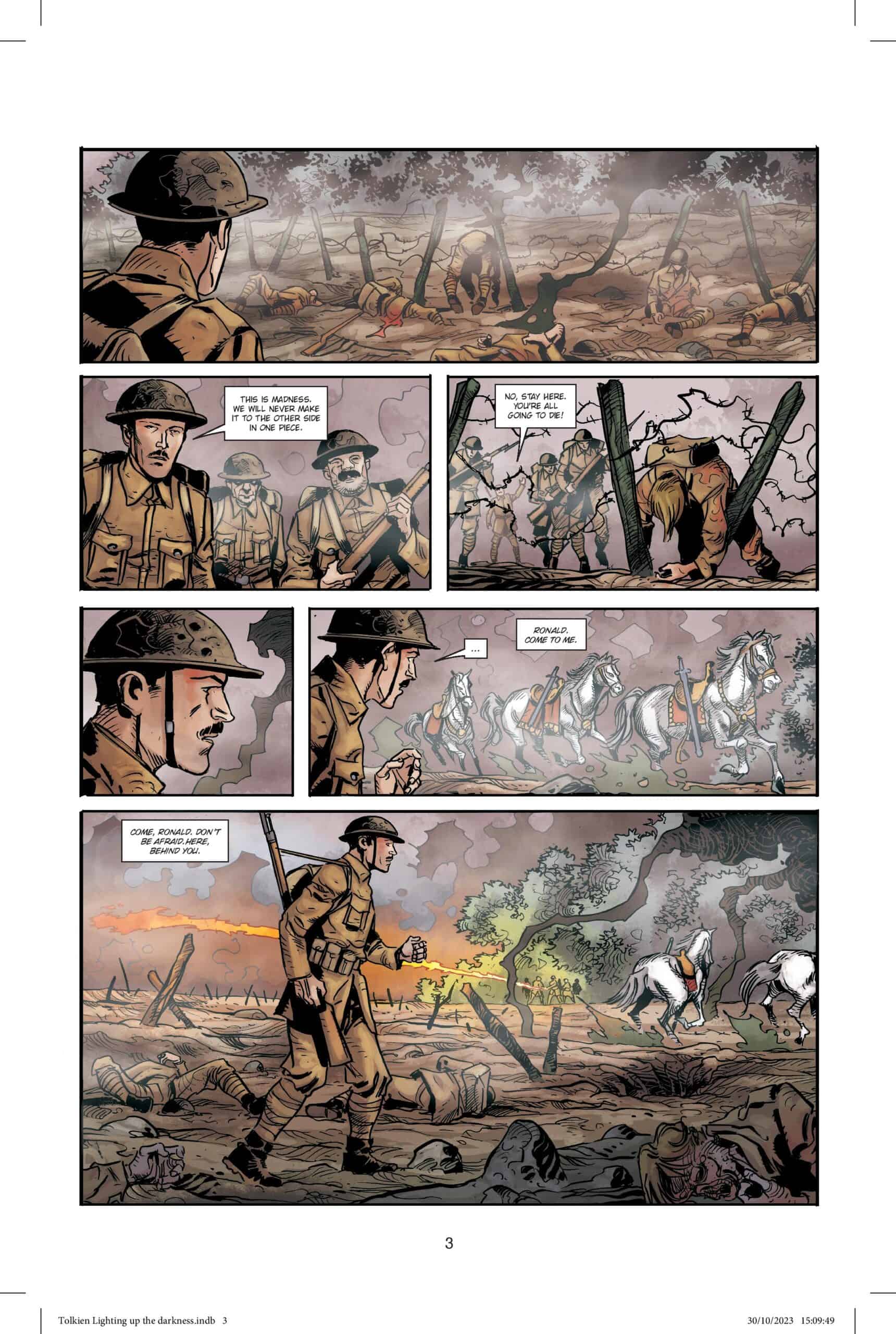
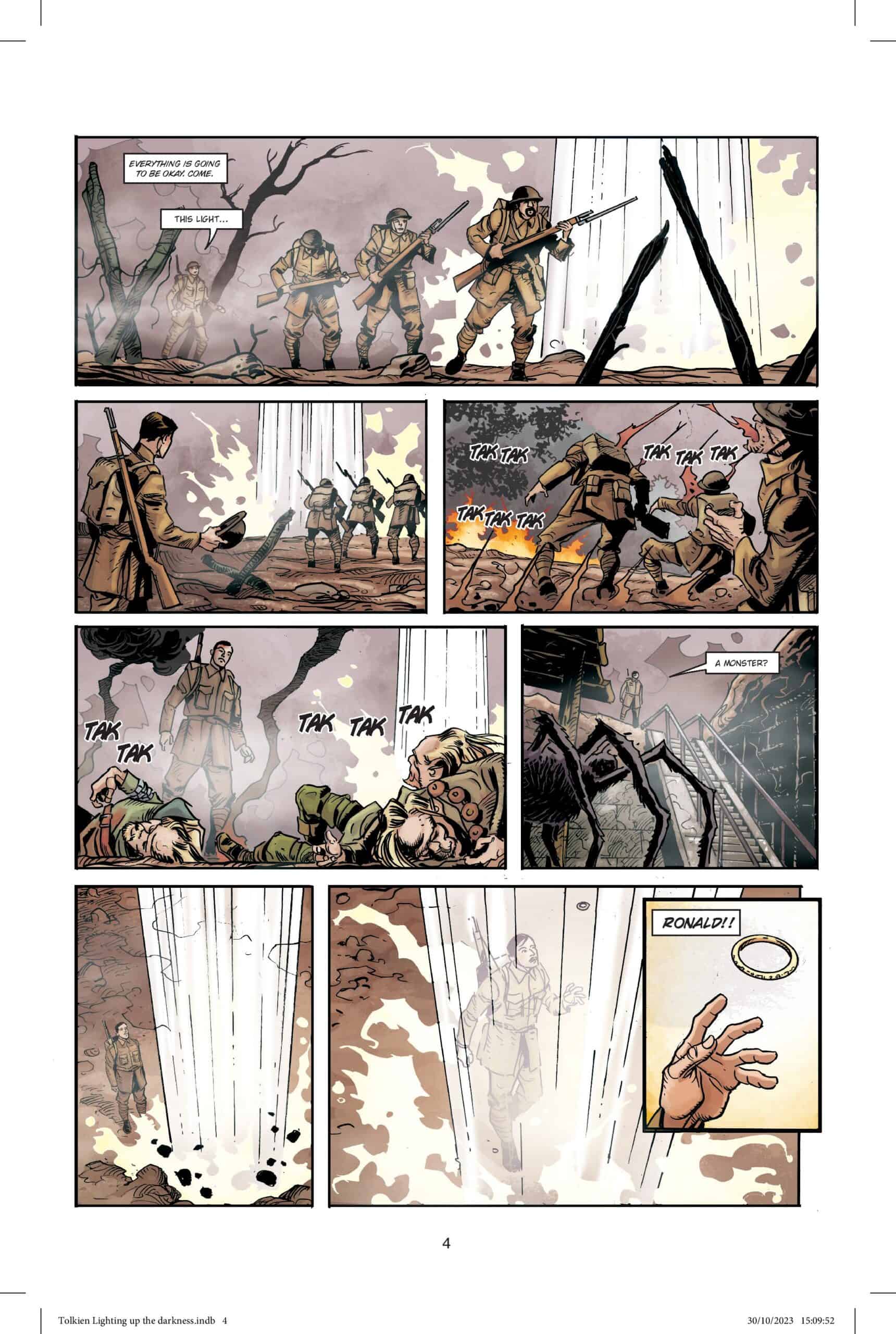
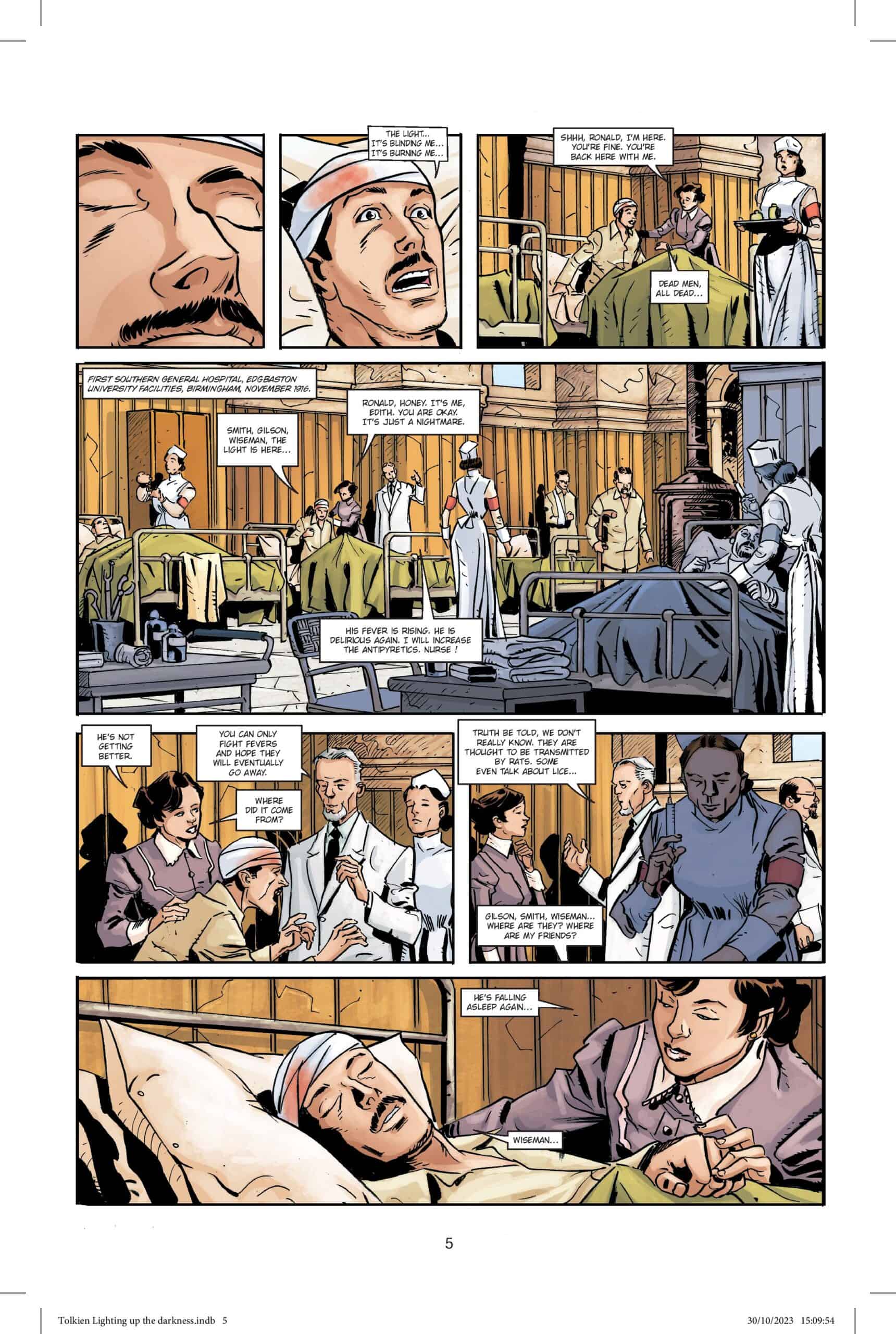
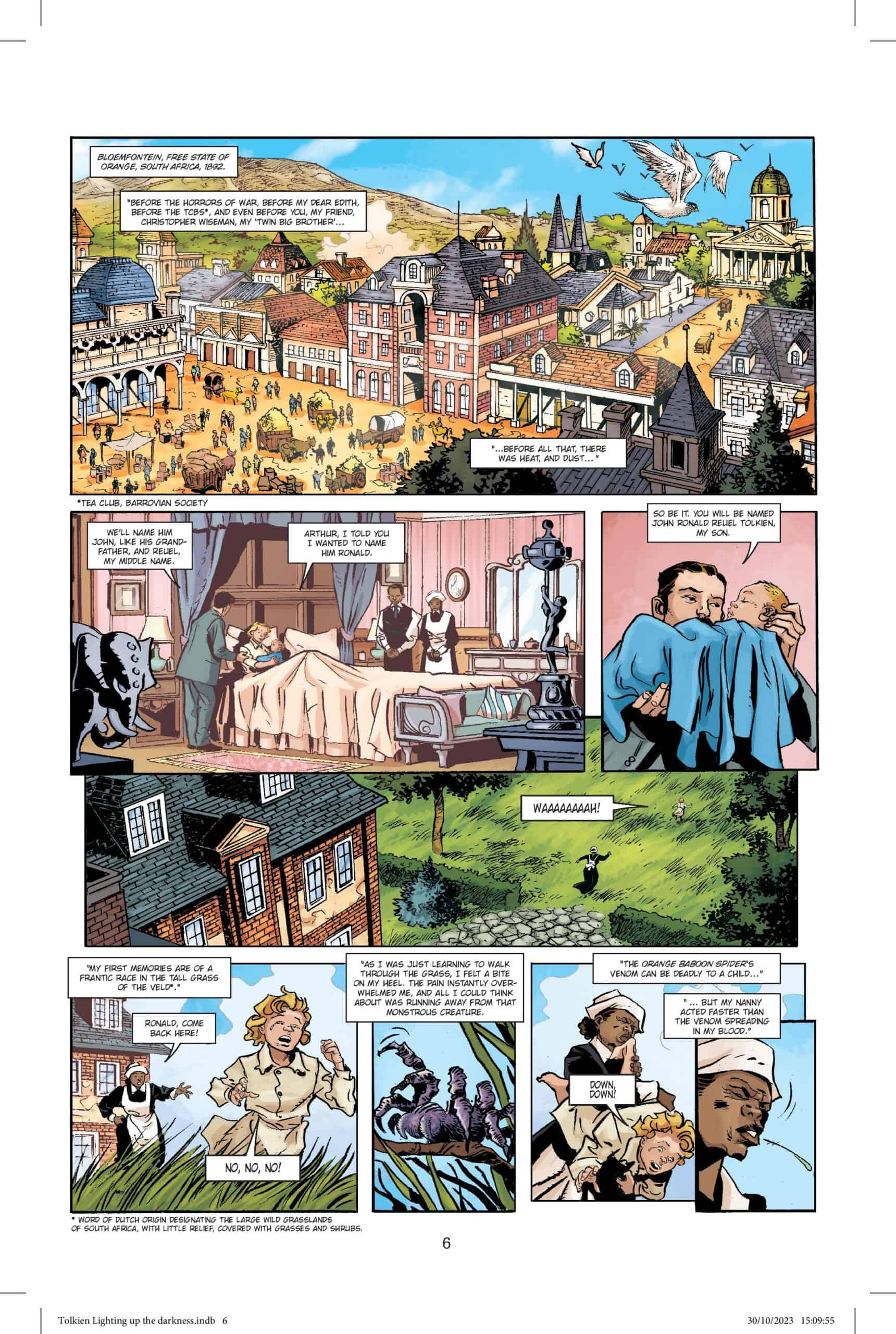
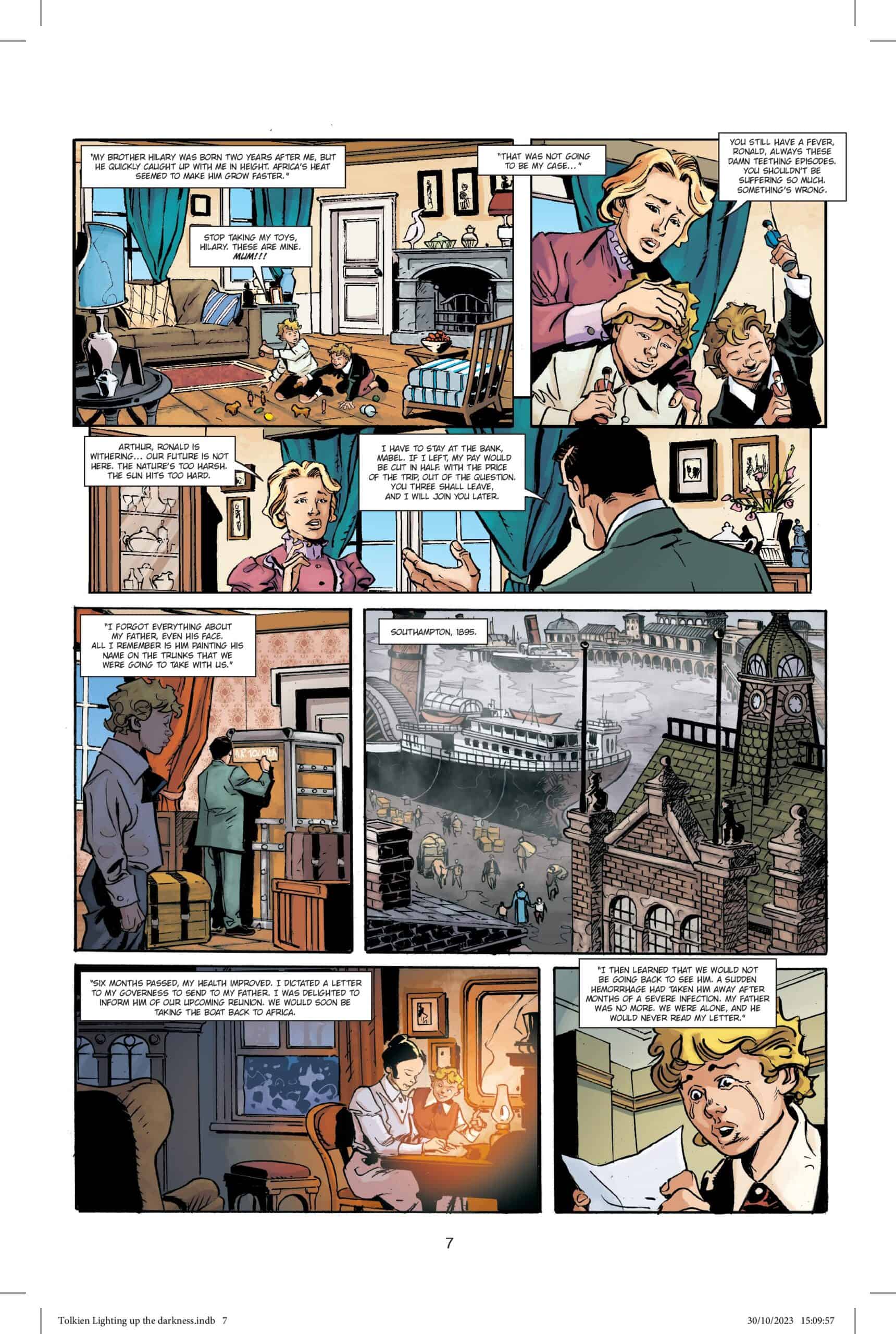
Comic Watch: What is your history with comic books? What Was your first experience with them or do you you remember the first one you read?
When I was a very young kid, I liked having my vast collection of Tintin comics all around me in my bed. My parents used to read them to me when I was a baby, and I fell in love with them. Eventually, I learned how to read Tintin. The first comic I remember reading was “L’île mystérieuse” with the story of the ever-growing mushroom. It was my favourite, I don’t know why, but it really stuck with me.
For a long time I couldn’t sleep without these comics around me, a bit like Gaston Lagaffe sleeping in his secret room, filled to the brinks with books.
Comic Watch: What made you want to get into the comic industry?
It’s an interesting question since it’s clearly an impulse that comes from those early childhood memories. I grew up in a small village, far from any big city. There were around 100 people in the village, no shops, and one church. Nothing ever happened there…just farms, beautiful landscapes, lakes and forest. But it was a great playground for a kid with a bike.
My parents were the village primary school teachers. They also had the opportunity to open a small public library near the school. Every six months, a big bus from the city came to the village, filled with books. My parents selected titles for the library, as well as for villagers who had made specific requests. I was able to select the children’s comics that would remain in stock in the library. I could often even read the books first, it was like Christmas, but better. There were scores of new comics I was able to discover. I waited for that bus so much, and thanks to my parents’ library, I read hundreds if not thousands of comics while I was still a kid.
Most of my first readings were the Franco-Belgian classic comics : Astérix, Lucky Luke, Tintin, Gaston Lagaffe, Chick Bill – the classics. Then I moved to Van Hamme’s XIII, Thorgal, Largo winch, then Tardi, Bilal, Giraud/Moebius and many more. Manga was always very popular in France and I devoured titles like Dragon Ball, Akira, and Ghost in the Shell. Some of my favorite American comics ranged from X-men to my father’s old comics like Meteor and Cosmos. I had an epiphany like many when I got to Alan Moore’s Watchmen, Swamp Thing, Supreme, The League of Extrordinary Gentlemen and all the rest of his work. Moore made me realise the power of scriptwriting.
I followed a course in audiovisual fiction scriptwriting and worked for French tv dramas. But I always dreamed of writing a comics and working in this field, it has always been my favorite medium, so I followed this path.
Comic Watch: What is the elevator pitch for the graphic novel?
I’d summarize it like this: Behind Tolkien’s work, there is a story of youth and friendship as powerful as the ones which can be found in his books. This friendship, challenged by the horrors of the First World War, left a trauma which Tolkien was able to transcend and use to create the greatest modern-day English mythology.
Comic Watch: What is it that made J.R.R. Tolkien an interesting subject to want to chronicle his story as a graphic novel?
Alongside comics, Tolkien was my great teenage passion. The idea of mixing both of these passions had been with me for a long time. The possibility of working on this subject was made possible by the concomitance of ceremonies in France commemorating World War I. I also wanted to work on the contribution of the English during the battle of the Somme as French are often more knowledgeable on the French exploits at the Marne and the Battle of Verdun.
Tolkien’s youth is a story of a profound friendship confronted with the horrors of the war. I wanted to express how his creativity, which could be considered futile by some during these difficult times, ultimately becomes the only reasonable thing to cling to, the last thing left sane when the whole world goes crazy.
The comics and books both share a somewhat similar intimate approach to storytelling, a similar rhythm of reading, discovering and world building. Using comics to depict Tolkien’s early life seemed like the perfect medium.
Comic Watch: How did you go about researching the life of Tolkien?
For a long time, I have been reading everything I could about Tolkien. I am fascinated by the rhythm of his life, from this ultimate war experience to the aftermath as a quiet professor in Oxford writing his master work in his free time. I find his dedication to his masterwork so moving and impressive, I read everything about his life and his way of creating.
For the start, I wanted to stay as true as possible to Tolkien’s life, to evoke it through the dialogues and to make it familiar to those who know the work as well as those whom don’t, without entering into any anachronistic fantasy.
Comic Watch: Was there something you learned while working on the graphic novel that you hadn’t known about Tolkien that you found particularly interesting?
I was amazed by the ability of Tolkien and his brother to create languages to communicate with each other as children without anyone else understanding them. It requires quite an amazing intelligence, that always struck me.
Comic Watch: Who are the artist and rest of the creative team on the book and how did you get connected with them?
I previously wrote two comics for the French publisher, Glénat, and I met my editor, Jean Waquet, from Soleil with this project. We looked for a very clear line drawing style, like a post-modern old-fashioned Franco-Belgian comic strip, something classic and not too modern, to stay close to Tolkien’s own personality and work and the era in which he lived. Jean introduced me to artist Giancarlo Caracuzzo, who seemed like the perfect fit for the project.
Giancarlo understood what we were looking for and was passionate about period drawings, costumes and integrating this clear classical line narration. He lives in Rome and I live in Paris and we communicated through numerous video calls and emails to discuss the project, go over archives, discuss images of costumes, weapons, and so on.
Comic Watch: Can you walk me through the creative process between you and the artist when working on the book?
At every stage I worked closely with Jean and Giancarlo. I first wrote a script, and for each panel, there was a whole slew of historical, societal, references and explanations on Tolkien’s work.
Giancarlo similarly did his own research and and made suggestions when he had a better visual idea. It was a very interesting three-way game of creative ping pong with Jean who was always very present and curious during the process. He let us move forward at our own pace, trusting us every step of the way.
We had to present Tolkien and his friends but also what English society and Europe were at that time. The codes of honor, the conflicts between Catholics and Anglicans, the many nuances that weaved the fabric of society at the time.
It was also necessary to address both the neophyte as well as the enlightened reader of Tolkien, which was quite a challenge. But I think that we we managed to find the balance, to remain faithful to explaining his life by showing things without explaining more than necessary. I hope that after reading this story, readers will want to extend their experience by searching for particular passages to learn more about them : Oxford during the war, the Kalevala, Beowulf, the Battle of the Somme, so many fascinating topics to get familiar with !
Comic Watch: Are there any other writers that you would like to give the same treatment in the future?
No, I don’t think I would want to. JRR Tolkien and this particularly moving story of friendship during the war is really special for me.
An important part of this comic book was to reflect on the relationship between the author’s life and his work. It is particularly touching and gut-wrenching to find the resonance of the battle of the Somme in the dead marshes of Mordor for example, or to imagine the discovery of the first tanks, magnified into fire-breathing mechanical dragons. I also wanted the reader to keep in mind Tokien’s love of nature and his hatred of the soulless industry that poisons the soil, which still seems relevant to me, now more than ever,
TOLKIEN: LIGHTNING UP THE DARKNESS is now available for purchase at comic book shops and through Ablaze’s website





